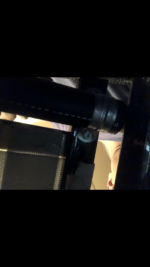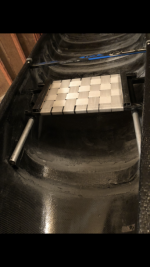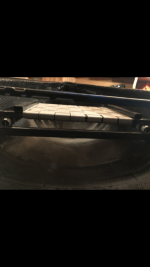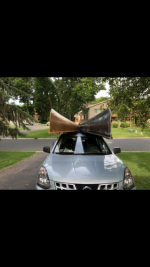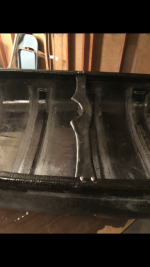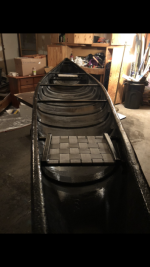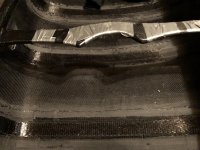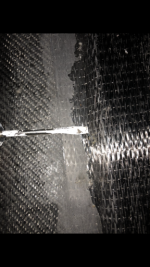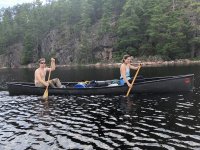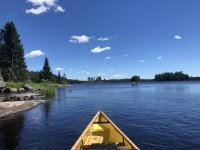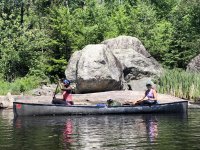Sounds like there is no simple home solution here. I tried out Alans idea with the thin fiberglass over the carbon fabric last night (3 oz satin, style 120). It looked like it was going to be perfect until the edges started sliding off the underbelly of the yoke. That Weezer Sweater song was appropriately going through my head and it was a bit of a scramble to salvage it while it cured. If I had any peel ply left, I would have used it to hold the bottom overlap in place and it probably would have worked great. Oh well, onto the sanding...
-
Happy National Eggnog Day! 🎄🥛😵
You are using an out of date browser. It may not display this or other websites correctly.
You should upgrade or use an alternative browser.
You should upgrade or use an alternative browser.
Carbon Innegra canoe build
- Thread starter Mrindy
- Start date
Haha yeah Jim but that would be too easy! Live and learn. The yoke turned out ok - not pretty but functional. I can say the same for the boat which I have been frantically trying to get to a minimum viable product for our Bwca trip leaving today. We sanded and covered the gunwales with epoxy + graphite powder but that thick weave will require another coat some other time. The hull needs either another fill coat of epoxy or varnish (inside and out) as well, but at least we wont cut ourselves on it while paddling! Here are a few pics of the (nearly) finished product and some shots of how I did the sliding bow seat. Maiden voyage coming up on Hegman lake!
Attachments
Forgot to add - it is really lightweight. I didnt have a scale handy, but it is noticeably lighter than its 42-43 lb twin and feels closer to my first build which is 37 lb. Not bad for an 18 footer with added freeboard. The hull is even thicker than the aforementioned factory built one. Go Innegra I guess!
Nice work! I hope the trip report is ready soon!
Jason
Jason
Back from the BWCA! We picked a route that had a LOT of portaging. If anyone is familiar with the area, that 1.5 mile portage from Hegman to Angleworm is the most rugged one I have seen in BW. The canoe held up pretty well considering it was her maiden voyage. I dont have a scale but I would not be surprised if the canoe came in around 35 lbs. It is crazy. Another fill coat will likely add a bit, but I couldnt be happier with the weight.
Now onto the issues. I either did not give it enough time to cure, didnt use enough fabric, or pushed the limit of the pink foam, but the yoke bent after a few portages. I took out the front hockey stick thwart near the seat and duct-taped it for support. No issues the rest of the trip - it will probably become a permanent part of the yoke unless I go buy or make a wood one. Future builders be warned.
The other issue came with the uni directional cf on the ribs. Someone slipped and threw the canoe down hard on the last portage of the trip and the cf where the rib meets the hull separated slightly. Duh, it is unidirectional. I wouldnt use that fabric again. I think I will glass over these spots on all the ribs as it is the natural weak point and could happen again. Other than that, it was very functional, fast, and light!
Now onto the issues. I either did not give it enough time to cure, didnt use enough fabric, or pushed the limit of the pink foam, but the yoke bent after a few portages. I took out the front hockey stick thwart near the seat and duct-taped it for support. No issues the rest of the trip - it will probably become a permanent part of the yoke unless I go buy or make a wood one. Future builders be warned.
The other issue came with the uni directional cf on the ribs. Someone slipped and threw the canoe down hard on the last portage of the trip and the cf where the rib meets the hull separated slightly. Duh, it is unidirectional. I wouldnt use that fabric again. I think I will glass over these spots on all the ribs as it is the natural weak point and could happen again. Other than that, it was very functional, fast, and light!
Attachments
Pink Foam !!!!!! Beware !
I think I warned you about it before ! Ha ! Well at least now you know !
If I ever get caught up having fun, I'll replace the PINK FOAM core in my First Kevlar.
Glad you made it back, and really put your composite to the test !
Jim
I think I warned you about it before ! Ha ! Well at least now you know !
If I ever get caught up having fun, I'll replace the PINK FOAM core in my First Kevlar.
Glad you made it back, and really put your composite to the test !
Jim
Ha! You certainly did! I have gotten away with the 1/2 in stuff on ribs with my kevlar build as well, and so far so good on the gunwales. But that direct load bearing yoke seems to be where it ends. I can see how a complete foam core of it would be problematic, especially if it were any thinner. Did you just glass over it I hope?
How many layers and what weights of cloth did you use on your yoke? I've had no problems with the pink/blue construction foam in my yoke. I think I used two layers overall but I was using 19oz. cloth.
When using the more standard 6oz. cloth over construction foam I've found you need at least 2 layers of carbon before it's stiff enough to not depress under your finger tip when pressing hard. Not that that's a problem on every part but gives you an idea.
I felt a small sample of the divinycell foam that stripperguy sent to Jim and I couldn't feel any depression when pinching just the bare foam.
Glad to hear it was a success overall.
Alan
When using the more standard 6oz. cloth over construction foam I've found you need at least 2 layers of carbon before it's stiff enough to not depress under your finger tip when pressing hard. Not that that's a problem on every part but gives you an idea.
I felt a small sample of the divinycell foam that stripperguy sent to Jim and I couldn't feel any depression when pinching just the bare foam.
Glad to hear it was a success overall.
Alan
I used multiple layers of carbon, adding up to 18-20 oz per side, in line with what I saw on your post, Alan. The yoke felt really hard before I installed it - no depressioning at all. I did not witness it bending so I suppose someone could have put all their weight on it jumping across the canoe or something and not wanting to admit it.
Good call letting someone else paddle it. Sometimes I think it's more fun to be able to watch your boat than it is to paddle it.
I'm surprised the yoke failed with that much cloth. Maybe it wasn't quite fully cured yet or maybe, like you say, something else bad happened to it that you didn't see.
Mine is narrower though since it only had to span a solo and parts of it are quite thick since I sculpted it to try and fit my shoulders better than a flat one. I think I started with 2" foam.
When I got done with mine I let it span an opening (like a bridge) and put some of my weight on it to see how much it flexed. I didn't measure how much I leaned on it but it was a good deal more than the boat weighed and the flex was similar to a 3/4" wood yoke.
Alan
I'm surprised the yoke failed with that much cloth. Maybe it wasn't quite fully cured yet or maybe, like you say, something else bad happened to it that you didn't see.
Mine is narrower though since it only had to span a solo and parts of it are quite thick since I sculpted it to try and fit my shoulders better than a flat one. I think I started with 2" foam.
When I got done with mine I let it span an opening (like a bridge) and put some of my weight on it to see how much it flexed. I didn't measure how much I leaned on it but it was a good deal more than the boat weighed and the flex was similar to a 3/4" wood yoke.
Alan
Yes - it was fun to see other people zipping through the water in it and see my hard work on display! I wish I would have had time to do more testing on the yoke like you did, and good to know that there are success stories with that foam, albeit the thicker variety.
I just bought a scale and confirmed my suspicion - it came in at 34.4 lbs!!! Crazy for an 18 footer. Another fill coat and rib reinforcement should still keep it in the 35-36 lb range. I think the hockey stick seats are a big part of the weight savings, they felt like ounces. The 3.16 oz glass probably contributed to it as well.
I just bought a scale and confirmed my suspicion - it came in at 34.4 lbs!!! Crazy for an 18 footer. Another fill coat and rib reinforcement should still keep it in the 35-36 lb range. I think the hockey stick seats are a big part of the weight savings, they felt like ounces. The 3.16 oz glass probably contributed to it as well.
I think the hockey stick seats are a big part of the weight savings, they felt like ounces. The 3.16 oz glass probably contributed to it as well.
I think you're right. If you want a super light build you need to keep everything light from start to finish. Trim is where a lot of canoes gain weight. You can knock yourself out trying to shave a pound or two off the hull but it's pretty easy to cut 6 pounds off trim.
Alan
34.4 lbs!! Congrats! That's a great weight, rivals most production lightweight boats...and probably higher quality too!
Nice work, man.
Nice work, man.
Well I don't have any advise on the yoke, but those pictures are nice! Congrats on your canoe!
Jason
Jason
I think you're right. If you want a super light build you need to keep everything light from start to finish. Trim is where a lot of canoes gain weight. You can knock yourself out trying to shave a pound or two off the hull but it's pretty easy to cut 6 pounds off trim.
Alan
Alan is spot on, the trim work on a Merrimack is almost 20 lbs - wood gunwales,decks, handles, seats, thwarts and yoke.
Nice job!
That is one light boat! Lighter than my current solo build. You should be proud!
I love the use of hockey sticks, great idea! I may have to use that at some point when I decide to revisit the idea of an all fabric composite build.
Did you weigh any of those hockey stick seats? I am very curious what they weigh...
That is one light boat! Lighter than my current solo build. You should be proud!
I love the use of hockey sticks, great idea! I may have to use that at some point when I decide to revisit the idea of an all fabric composite build.
Did you weigh any of those hockey stick seats? I am very curious what they weigh...
Thanks Steve! I pulled out the front sliding seat and it weighed 1.5 lbs. That one is 2 in. wider and has some aluminum brackets and pvc pipe attached to it so the rear seat is for sure lighter. So maybe 2.5 lbs total weight for seats? I highly recommend trying to round up some free sticks from your local rink in late winter/early spring to anyone considering an ultra light build!
I am also a fan of using a lighter e-glass on the outside of the hull as long as you go with a good s-glass football and skid plates. That should be the only part that is taking the beating on rocks and logs and stuff anyway. The only other thing I can think of that made it so light is the peel ply - perhaps it soaked out some of the excess resin?
I am also a fan of using a lighter e-glass on the outside of the hull as long as you go with a good s-glass football and skid plates. That should be the only part that is taking the beating on rocks and logs and stuff anyway. The only other thing I can think of that made it so light is the peel ply - perhaps it soaked out some of the excess resin?
Similar threads
- Replies
- 14
- Views
- 935
- Replies
- 13
- Views
- 2K
- Replies
- 43
- Views
- 8K
- Replies
- 8
- Views
- 2K

